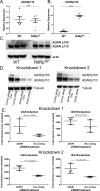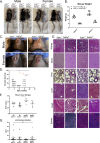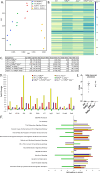ADAR1 haploinsufficiency and sustained picornaviral RdRp dsRNA synthesis synergize to dysregulate RNA editing and cause multi-system interferonopathy
- PMID: 40693792
- PMCID: PMC12345148
- DOI: 10.1128/mbio.01492-25
ADAR1 haploinsufficiency and sustained picornaviral RdRp dsRNA synthesis synergize to dysregulate RNA editing and cause multi-system interferonopathy
Abstract
Sensing of viral double-stranded RNA (dsRNA) by MDA5 triggers abundant but transient interferon-stimulated gene (ISGs) expression. If dsRNA synthesis is made persistent by transgenically expressing a picornaviral RNA-dependent RNA polymerase (RdRp) in mice, lifelong MDA5-MAVS pathway activation and marked, global ISG upregulation result. This confers robust protection from viral diseases, but in contrast to numerous other chronic MDA5 hyperactivation states, the mice suffer no autoimmune or other health consequences. Here, we find that they further confound expectations by being resistant to a strong autoimmunity (lupus) provocation. However, knockout of one allele of Adar breaks the autoinflammation-protected state of RdRptg mice and results in a severe disease that resembles interferonopathies caused by MDA5 gain-of-function protein mutations. Adar+/- mice are healthy, but Adar+/- RdRptg mice have shortened lifespan, stunted growth, premature fur graying, poorly developed teeth, skeletal abnormalities, and extreme ISG elevations. A-to-I edits are both abnormally distributed and increased (numbers of genes and sites). These results, with a nucleic acid-triggered and MDA5-wild-type model, illuminate the ADAR1-MDA5 axis in the regulation of innate immunity and establish that viral polymerase-sourced dsRNA can drive autoinflammatory disease pathogenesis.
Importance: RNA virus double-stranded RNAs (dsRNAs) are important pathogen-associated molecular patterns that are sensed by the RIG-I-like receptor MDA5, which triggers an acute innate immune response involving many interferon-stimulated genes (ISGs). One key to a healthy innate immune system is that MDA5 does not sense endogenous dsRNA. This is normally ensured by dsRNA duplex-disrupting ADAR1 editing of host dsRNAs. Picornavirus RdRptg mice have an unusual constitutive MDA5 activation state, with very high lifelong MDA5-mediated ISG expression that confers robust protection from diverse lethal viruses. Importantly, and in contrast to numerous other chronic MDA5 hyperactivation states, the mice develop no autoinflammatory consequences. If we delete one ADAR1 allele, however, which by itself is well tolerated, the mice develop a multisystem disease that resembles the human interferonopathy Singleton-Merten syndrome. In contrast to other MDA5/ADAR1 disease models, the MDA5 and ADAR1 proteins are both wild type in this dsRNA-driven model.
Keywords: ADAR1; MDA5; RdRp; autoimmunity; autoinflammation; innate antiviral immunity; interferonopathy; lupus; picornavirus.
Conflict of interest statement
The authors declare no conflict of interest.
Figures







Update of
-
ADAR1 haploinsufficiency and sustained viral RdRp dsRNA synthesis synergize to dysregulate RNA editing and cause multi-system interferonopathy.bioRxiv [Preprint]. 2025 May 28:2025.01.21.634124. doi: 10.1101/2025.01.21.634124. bioRxiv. 2025. Update in: mBio. 2025 Aug 13;16(8):e0149225. doi: 10.1128/mbio.01492-25. PMID: 39896491 Free PMC article. Updated. Preprint.
Similar articles
-
ADAR1 haploinsufficiency and sustained viral RdRp dsRNA synthesis synergize to dysregulate RNA editing and cause multi-system interferonopathy.bioRxiv [Preprint]. 2025 May 28:2025.01.21.634124. doi: 10.1101/2025.01.21.634124. bioRxiv. 2025. Update in: mBio. 2025 Aug 13;16(8):e0149225. doi: 10.1128/mbio.01492-25. PMID: 39896491 Free PMC article. Updated. Preprint.
-
Smooth muscle expression of RNA editing enzyme ADAR1 controls activation of RNA sensor MDA5 in atherosclerosis.bioRxiv [Preprint]. 2025 Jun 25:2024.07.08.602569. doi: 10.1101/2024.07.08.602569. bioRxiv. 2025. PMID: 39026721 Free PMC article. Preprint.
-
Prescription of Controlled Substances: Benefits and Risks.2025 Jul 6. In: StatPearls [Internet]. Treasure Island (FL): StatPearls Publishing; 2025 Jan–. 2025 Jul 6. In: StatPearls [Internet]. Treasure Island (FL): StatPearls Publishing; 2025 Jan–. PMID: 30726003 Free Books & Documents.
-
Leveraging genetics to understand ADAR1-mediated RNA editing in health and disease.Nat Rev Genet. 2025 Aug;26(8):532-546. doi: 10.1038/s41576-025-00830-5. Epub 2025 Apr 14. Nat Rev Genet. 2025. PMID: 40229561 Review.
-
ADAR1, inosine and the immune sensing system: distinguishing self from non-self.Wiley Interdiscip Rev RNA. 2016 Mar-Apr;7(2):157-72. doi: 10.1002/wrna.1322. Epub 2015 Dec 21. Wiley Interdiscip Rev RNA. 2016. PMID: 26692549 Review.
References
-
- Kato H, Takeuchi O, Mikamo-Satoh E, Hirai R, Kawai T, Matsushita K, Hiiragi A, Dermody TS, Fujita T, Akira S. 2008. Length-dependent recognition of double-stranded ribonucleic acids by retinoic acid-inducible gene-I and melanoma differentiation-associated gene 5. J Exp Med 205:1601–1610. doi: 10.1084/jem.20080091 - DOI - PMC - PubMed
MeSH terms
Substances
Grants and funding
LinkOut - more resources
Full Text Sources
Research Materials
Miscellaneous

